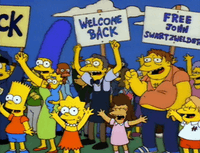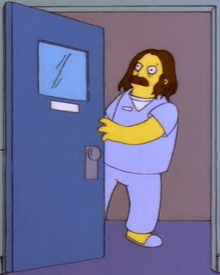Hurricane Neddy
| "Hurricane Neddy" | |
|---|---|
| The Simpsons episode | |
| Episode no. | 161 |
| Directed by | Bob Anderson |
| Written by | Steve Young |
| Showrunner(s) |
Bill Oakley Josh Weinstein |
| Production code | 4F07 |
| Original air date | December 29, 1996 |
| Couch gag | The couch is replaced with a coin slot and the words "Vend-A-Couch" are written on the wall. Homer puts a coin in; nothing happens. Homer pounds on the wall before the couch falls on him.[1] |
| Commentary |
Josh Weinstein Steve Young George Meyer Bob Anderson |
| Guest appearance(s) | |
|
Season 8 episodes
| |
| Seasons | |
"Hurricane Neddy" is the eighth episode of The Simpsons' eighth season. It originally aired on the Fox network in the United States on December 29, 1996.[2] It was written by Steve Young, directed by Bob Anderson, and features a cameo by Jon Lovitz as Jay Sherman from The Critic.[1] In the episode, "Hurricane Barbara" viciously strikes Springfield but, by pure chance, the house of Ned Flanders is the only one destroyed. As a result, he begins to lose his faith in both God and the townspeople around him as he suffers a nervous breakdown.
Plot
In the midst of a quiet afternoon, the wind starts to pick up, which leads Lisa to find out that a hurricane is on the way. The evening news confirms that "Hurricane Barbara" is close, resulting in panicked citizens storming the Kwik-E-Mart. The hurricane strikes, and after a few treacherous hours, the storm ends. The Simpsons cautiously leave their basement and learn that the home is untouched. Next door, Ned Flanders emerges from a heap of rubble and sees that although his family is safe, his house has been destroyed. The Flanders family is forced to move into the Rescue Center in the church basement. Ned is further discouraged after learning that his business The Leftorium was looted following the hurricane. Distraught with annoyance, Ned begins to believe that God is punishing him like Job.
The following day, Marge arrives at the church and takes the Flanders family back to their house, completely "rebuilt" by the people of Springfield. Overjoyed, Ned inspects the house, but becomes increasingly dismayed as he discovers its extremely shoddy construction. Immediately after the inspection, the house collapses. Ned initially tries to remain calm, but after inadvertently breaking his glasses he is unable to contain his rage and finally snaps, lashing out at the residents. Ned drives to a mental hospital to seek psychotherapy. Ned is visited by his childhood psychiatrist, Dr. Foster, who tells Ned about his childhood as an out-of-control brat raised by beatnik parents. Ned's treatment involved eight months of continuous spanking. The treatment worked so well that it rendered him unable to express any anger, and Ned's repressed anger built up inside him until he erupted.
Dr. Foster enlists Homer to help Ned learn how to appropriately express emotions. After several failed scripted insults, Homer manages to get Ned to open up about some of his repressed dislikes, finally admitting he hates post offices and his parents, after which he immediately feels better. Dr. Foster declares Flanders cured and he is immediately released. Outside the hospital, Ned is greeted by the townsfolk of Springfield, including the rest of the Simpsons and his family. Ned promises that from now on, if anyone does something he does not like, they will hear about it, which Dr. Foster tells him is very healthy. Homer then tells Ned he's crazy as they both laugh.[2][3]
Production

Steve Young, a writer for the Late Show with David Letterman, was brought in as a freelance writer to write the episode.[4] The writers wanted to explore what made Flanders tick and examine what made him act the way he does.[4] The original idea came from George Meyer, who had also wanted an episode about Flanders' faith being tested.[5] One of the key story points came from his friend Jack Handey, a writer for Saturday Night Live, who wanted to do a sketch about a down-on-his-luck shoemaker who is visited by elves who help him, but make very bad shoes. Likewise, it inspired the idea that the neighbors would rebuild Flanders' house, but do a bad job and provoke an outburst.[5]

A caricature of John Swartzwelder can be seen shutting the door of a room in Calmwood Mental Hospital.[4] Later in the episode, during the scene where the townsfolk are welcoming Ned back, someone can be seen holding a sign that says "Free John Swartzwelder".[5] During the sequence where Flanders yells at the town, a man with a ponytail and wearing a white shirt who is a caricature of Bob Anderson can be seen.[6]
Cultural references
The scene at the beginning of the episode, in which the people of Springfield mob the Kwik-E-Mart, is based on the events of the 1992 Los Angeles riots.[4] Todd is wearing a Butthole Surfers shirt; however, the censors only allowed "Buttho Surfers".[4] Jay Sherman from The Critic, who had previously appeared in "A Star Is Burns", can also be seen in the mental hospital repeatedly saying his catchphrase, "It stinks".[4] The small door at the end of the hallway in Flanders' rebuilt house echoes the improbably small hallway in the film Willy Wonka & the Chocolate Factory.[4]
Reception
In its original broadcast, "Hurricane Neddy" finished 18th in ratings for the week of December 23–29, 1996, with a Nielsen rating of 8.7, equivalent to approximately 8.4 million viewing households. It was the second-highest-rated show on the Fox network that week, following The X-Files.[7]
Marge's line, "Dear God, this is Marge Simpson. If You stop this hurricane and save our family, we will be forever grateful and recommend You to all our friends", was cited by journalist Mark Pinsky as an example of how "Simpson family members are both defined and circumscribed by religion."[8] Journalist Ben Rayner speculated that some fans, whom he called "nerds", would want an explanation of "how Barney fit through that tiny door to the 'master bedroom' in the rebuilt Flanders family home."[9]
References
- 1 2 Hurricane Neddy. BBC.co.uk. Retrieved on March 27, 2007.
- 1 2 "Hurricane Neddy". The Simpsons.com. Retrieved on March 27, 2007.
- ↑ Groening, Matt (1997). Richmond, Ray; Coffman, Antonia, eds. The Simpsons: A Complete Guide to Our Favorite Family (1st ed.). New York: HarperPerennial. p. 173. ISBN 978-0-06-095252-5. LCCN 98141857. OCLC 37796735. OL 433519M.
- 1 2 3 4 5 6 7 Weinstein, Josh (2006). The Simpsons season 8 DVD commentary for the episode "Hurricane Neddy" (DVD). 20th Century Fox.
- 1 2 3 Meyer, George (2006). The Simpsons season 8 DVD commentary for the episode "Hurricane Neddy" (DVD). 20th Century Fox.
- ↑ Anderson, Bob (2006). The Simpsons season 8 DVD commentary for the episode "Hurricane Neddy" (DVD). 20th Century Fox.
- ↑ Associated Press (January 3, 1997). "ABC ends up on top in a slow week". Sun-Sentinel. p. 4E.
- ↑ Victoria Combe, "Praise and glory to the God-fearing Homer Simpson: Chaotic cartoon family criticized as dysfunctional is defined by religion, journalist says in book", Standard, St. Catharines, Ontario: August 31, 2001, pg. A.1.FRO.
- ↑ Ben Rayner, "Offering up the goods on Springfield's finest; The Simpsons have breached the boundaries of animation. Today a director details how they do it, writes Ben Rayner", Toronto Star, October 30, 2005, pg. C.06.
External links
| Wikiquote has quotations related to: "Hurricane Neddy" |
- "Hurricane Neddy" at The Simpsons.com
- "Hurricane Neddy episode capsule". The Simpsons Archive.
- "Hurricane Neddy" at TV.com
- "Hurricane Neddy" on IMDb